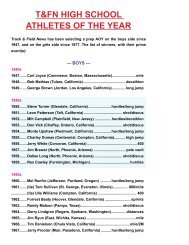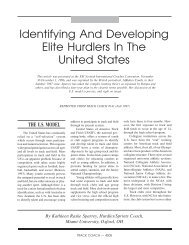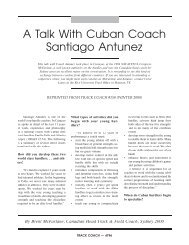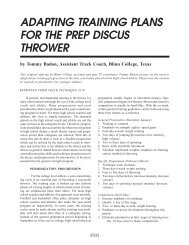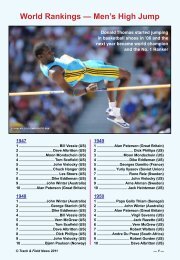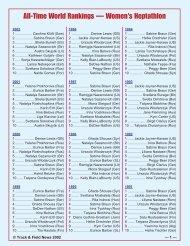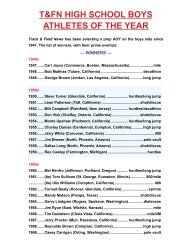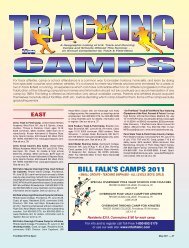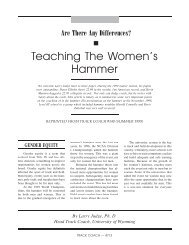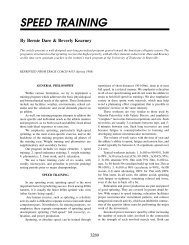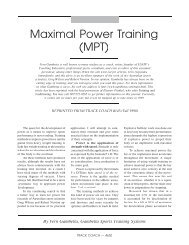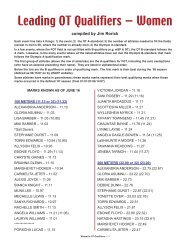Beyond Our Reach Forever? - Track & Field News
Beyond Our Reach Forever? - Track & Field News
Beyond Our Reach Forever? - Track & Field News
Create successful ePaper yourself
Turn your PDF publications into a flip-book with our unique Google optimized e-Paper software.
How to adapt to altitude training<br />
and when to come down before major<br />
competition are worthy subjects for an<br />
article in their own right. One major<br />
error is the belief that no race pace<br />
work can be done. This is not so. If<br />
a 28-minute 10k runner (67 secs/400)<br />
were to go to altitude he would certainly<br />
have difficulty doing repetition miles in<br />
4:28 with 45 secs recovery. However, he<br />
can do 25 x 400 in 67 secs with 30 secs<br />
recovery. Never to train at a race pace<br />
at all at altitude is a foolhardy practice<br />
and it will be noticed in performances<br />
at sea level on return.<br />
Two work physiologists have studied<br />
Kenyan runners in detail—Saltin<br />
(Sweden) and Noakes (South Africa).<br />
Their findings should be posted in every<br />
track & field department in universities<br />
and in athletics clubhouses. Briefly, their<br />
conclusions were:<br />
1. Many Kenyans (14-17 years) run at<br />
least six miles a day, some double<br />
that. This is of necessity to get<br />
to school or home, since public<br />
transport is rudimentary or nonexistent.<br />
2. In high school, a further six miles of<br />
running is done on top of that to get<br />
to and from school. Of this six miles,<br />
half is done at 5k speed—that’s 95%<br />
VO2max. Steady running can be between<br />
60 to 75% VO2max. There is<br />
no talk of lactate threshold running<br />
here! That sort of running for a 9<br />
minutes 2-miler would be 4:53/mile<br />
for 4 miles, and for an 11 minutes<br />
2-miler, 6:13/mile. These boys are<br />
running considerably faster than this<br />
from an early age.<br />
The other significant point is that<br />
the world’s leading work physiologists—Astrand,<br />
Costill, Saltin<br />
and Noakes—state that work at an<br />
athlete’s 5k speed is the greatest<br />
boost to the VO2max in the book.<br />
However, Russian women prefer<br />
continual exposure to 3k speed<br />
(100% VO2max). So, from a very<br />
early age Kenyan boys are increasing<br />
their VO2max.<br />
3. The Kenyan boys also kill two<br />
birds with one stone! The volume of<br />
training also improves the VO2max.<br />
Any runner who starts off with 30<br />
minutes of steady running a day and<br />
increases it by 5 minutes a day per<br />
week to 60 minutes (12 weeks later)<br />
will improve his VO2max by 10%,<br />
and if he continues in that fashion<br />
to 1 1/ 2 hours a day, he will improve<br />
a further 5%. After this (about 80<br />
miles), improvement in the VO2max<br />
rapidly tapers off. They must either<br />
make the 80 miles plus faster, or<br />
some of the 80 miles faster. It will<br />
be noted that the Kenyans at school<br />
are doing the latter.<br />
4. When it comes to the proportion<br />
of aerobic work and fast aerobic<br />
running in adult Kenyan runners<br />
compared to Western runners, it is<br />
clear that the latter are way behind<br />
in a year’s calculations. Fast aerobic<br />
running is that which is done between<br />
80 to 100% of the VO2max.<br />
Or—put another way—half-marathon<br />
speed through to 2-mile speed.<br />
The Kenyans devote one-third of<br />
their running to this work. Western<br />
runners devote a mere 10%. So, a<br />
Western runner who covers ten miles<br />
a day, six days a week—a total of<br />
3,120 miles annually—will only<br />
do 312 miles of fast aerobic work,<br />
while his Kenyan counterpart will be<br />
doing 936 miles in the 80 to 100%<br />
VO2max zone. Little wonder that the<br />
Kenyans at present are superior!<br />
5. The findings in (4) are confirmed<br />
by muscle biopsies carried out by<br />
Saltin on leading Kenyan runners.<br />
He found that in the thigh (rectus<br />
femoris) they contained the greatest<br />
amount of aerobic enzyme he had<br />
ever seen. And he’s seen a good<br />
many world-class runners in his<br />
time. This meant that they could<br />
alter pace without tiring easily. He<br />
also thought that daily exposure to<br />
undulating terrain contributed to<br />
this condition.<br />
6. The height/body ratio of Kenyan<br />
runners was superior to Caucasian<br />
runners. Give two athletes six feet<br />
tall, the Kenyan would weight 142<br />
lbs. on average, while Caucasian<br />
runners weighed 159 lbs. That extra<br />
17 lbs. will take its toll in any<br />
race beyond a mile. The weight<br />
difference is probably due to the<br />
faster proportion of running using<br />
up more calories and to their diet<br />
which is higher in fruit, vegetables<br />
and carbohydrates, and lower in<br />
meat than Caucasian runners.<br />
7. Finally, and a big factor, running is<br />
an opportunity to escape poverty.<br />
For every great Kenyan runner, there<br />
are ten schoolboys waiting to fill his<br />
shoes.<br />
So, what’s the bottom line? Many<br />
Western coaches are loath to change<br />
their ways. We have in England coaches<br />
who believe that trotting around the<br />
countryside in the winter, notching up<br />
100 miles a week, is going to make<br />
a great cross country runner. Great<br />
Britain’s results in the last World Cross<br />
Country Championships were the worst<br />
for a decade in the men’s division.<br />
We also have coaches who believe<br />
that young athletes should never exceed<br />
four miles a day up to the age of 18<br />
years. This seems to be a standard more<br />
or less approved of officially, because<br />
Great Britain does not have entrants in<br />
the World Junior Championships 10k,<br />
while some Kenyan juniors are recording<br />
world-class times at that age.<br />
The British coaching examination<br />
places great emphasis on periodization.<br />
There isn’t a world-class runner who<br />
adheres to periodization in its original<br />
form. When the writer spoke to a leading<br />
Kenyan about microcycles, macrocycles<br />
and mesocycles, he thought the subject<br />
was about new Japanese motorcycles!<br />
Invented by a Russian, period-ization<br />
has failed to produce a truly worldclass<br />
performer in the men’s division for<br />
a long time. Periodization is basically<br />
aimed at one peak performance. No<br />
top-class runner can afford one peak in<br />
a year. It’s dead, and should be buried.<br />
It’s results that count, and periodization<br />
has not brought results in Britain—in<br />
fact, the opposite.<br />
Now, let’s clarify this VO2max percentage<br />
business. If a runner has never<br />
raced 3k, 5k, 10k or the half-marathon,<br />
how does he know what speeds to train<br />
at? Well, a starting point is to take the<br />
1500m time per 400m and keep add-<br />
TRACK COACH — 4618



